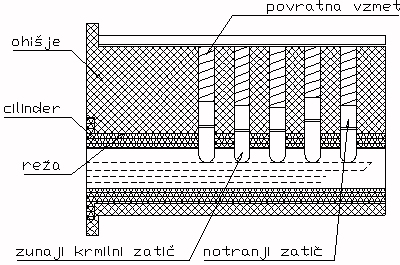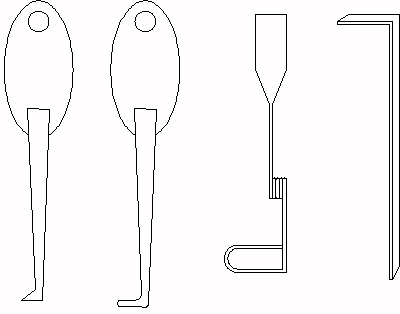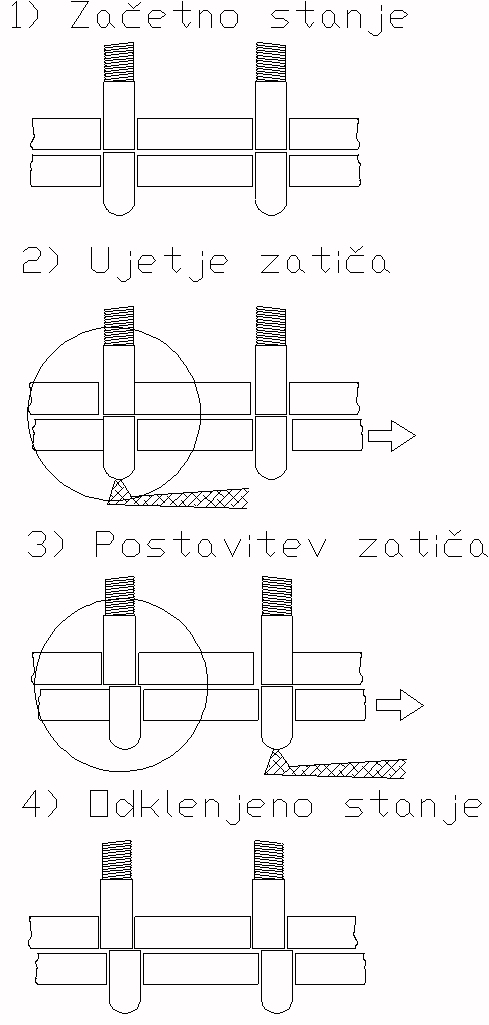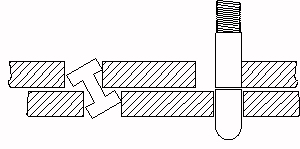A lock, specially its most important cylindrical part, must submit some contra dictionary demands like security, reliability, limited size, low costability, and long lasting. It's impossible to make a lock that fits to all of this demands. There is a rule that says as expensive a lock is, as safer it is. We must realise, that the lock is a very complicated mechanism that will undergo friction and wear. Low cost of a lock demands worse materials and mass production and that cause worse quality. However, the safetiness of the lock drops most because of the reliability. For a user it's most important, that he can still open the door after many years, after 10000 locking and unlocking the door, and with good knows which copy of the original key. There is no absolute safe lock in this world. Because of the inexact manufacturing and because of some on purpose made tolerances, it's quite easy to unlock the door without a key. In most cases, wear makes the whole think even easier.

 A cylindrical lock is assembled of a body, rotatible cylinder, pins and springs. Turning the key, before we put in the key is prohibited by pins. Pins are made in par. The one that's next to the spring is called the inside pin, the one that's next to the key is called the outside pin or the control pin. The inside pins al all of the same length meanwhile the control pines are all of different length. A great majority of the locks have 5 par of pins, that is enough for estimately 20000 different keys. The number of keys is duplicated by making the slot on the left or on the right side. Let's assign a number to each par of pins. Let's say that the pin next to the muzzle is number 1, the par next to it number 2 and so one. The point between the inside pin and the control pin will be called "joint", the slot between the body of the lock and the rotatible cylinder will be simply called "slot". We still need a word that describes an unviolent unlocking of the lock, with everything nut a key. Lt's say that is picking and the tool we need for that action is picking tool.
A cylindrical lock is assembled of a body, rotatible cylinder, pins and springs. Turning the key, before we put in the key is prohibited by pins. Pins are made in par. The one that's next to the spring is called the inside pin, the one that's next to the key is called the outside pin or the control pin. The inside pins al all of the same length meanwhile the control pines are all of different length. A great majority of the locks have 5 par of pins, that is enough for estimately 20000 different keys. The number of keys is duplicated by making the slot on the left or on the right side. Let's assign a number to each par of pins. Let's say that the pin next to the muzzle is number 1, the par next to it number 2 and so one. The point between the inside pin and the control pin will be called "joint", the slot between the body of the lock and the rotatible cylinder will be simply called "slot". We still need a word that describes an unviolent unlocking of the lock, with everything nut a key. Lt's say that is picking and the tool we need for that action is picking tool. The explanation will be much easier if we imagine a simplified model of a lock, that consists of two flat plates with holes and two par of pins. If we move one of the plates it always hits to one of the pines. The pine will be caught between the plates, that will try to cut it. (That phenomena will be named coughting). When the friction force becomes greater than the force of the spring, we become able to push the pin inside, until the "joint" comes in the "slot". We use our picking tool for this action. You will know when you reach the right position, because the plates will move a little bit and the inside pin will remain in its right position ( unlocked position). Will call that action fixing the pin. As soon as this happened the plates catch the next pin, that's why you will also feel a typical click. All you have to do now is to continue the same procedure up to the last (usually the fifth) pin. When all the pins are in fixed position the cylinder starts to rotate. Picking, beside the picking tool, we also need something to rotate the cylinder. However, we must submit a rotates moment during the picking, because the cutting force is necessary, when pushing the joint into the slot.
The explanation will be much easier if we imagine a simplified model of a lock, that consists of two flat plates with holes and two par of pins. If we move one of the plates it always hits to one of the pines. The pine will be caught between the plates, that will try to cut it. (That phenomena will be named coughting). When the friction force becomes greater than the force of the spring, we become able to push the pin inside, until the "joint" comes in the "slot". We use our picking tool for this action. You will know when you reach the right position, because the plates will move a little bit and the inside pin will remain in its right position ( unlocked position). Will call that action fixing the pin. As soon as this happened the plates catch the next pin, that's why you will also feel a typical click. All you have to do now is to continue the same procedure up to the last (usually the fifth) pin. When all the pins are in fixed position the cylinder starts to rotate. Picking, beside the picking tool, we also need something to rotate the cylinder. However, we must submit a rotates moment during the picking, because the cutting force is necessary, when pushing the joint into the slot. In praxis the pin number 5 is caught first, no. 4 is the second, 3 the third on so on until the number one. This is because of the wear. When we push the key into the lock, we force the pines to move up and down and that causes the wear of the pines and holes. The first pin wears the most and the last pin wears the least. However, that is only true if the pines are made exact enough. As big as the tolerances are, that easier is to unlock the door.
In praxis the pin number 5 is caught first, no. 4 is the second, 3 the third on so on until the number one. This is because of the wear. When we push the key into the lock, we force the pines to move up and down and that causes the wear of the pines and holes. The first pin wears the most and the last pin wears the least. However, that is only true if the pines are made exact enough. As big as the tolerances are, that easier is to unlock the door. Reading this you probably want to unlock a lock yourself, too. Well, when you will after many trials makeit, the feeling is something between victory and horror. The horror, because you realise that you have that kind of lock in your door too, and this is the only thing between the thieves and your property.
The locks are made in the way that playing with it is as hard as possible. The slot for the key is as thin as it can be, sometimes its also curved. A picking too must be made of some good steel, unfortunately that kin of steel is quite hard to deformate your own way. Some good picking tolls can be bought in special shops all around the world. For moving the pines you can use a larger hair clip, properly curved by usual ties. A screw driver would be perfect to make the rotating moment.
It is worth making a good tool. A steel that supports the rubber of windshield wiper, would be much better than a clip, but don't break it when you try to curve it. The time you will spent for making a good tool will be more than paid back wen you'll be opening the door with it..
Reading this you probably want to unlock a lock yourself, too. Well, when you will after many trials makeit, the feeling is something between victory and horror. The horror, because you realise that you have that kind of lock in your door too, and this is the only thing between the thieves and your property.
The locks are made in the way that playing with it is as hard as possible. The slot for the key is as thin as it can be, sometimes its also curved. A picking too must be made of some good steel, unfortunately that kin of steel is quite hard to deformate your own way. Some good picking tolls can be bought in special shops all around the world. For moving the pines you can use a larger hair clip, properly curved by usual ties. A screw driver would be perfect to make the rotating moment.
It is worth making a good tool. A steel that supports the rubber of windshield wiper, would be much better than a clip, but don't break it when you try to curve it. The time you will spent for making a good tool will be more than paid back wen you'll be opening the door with it..Before you start, try to find out in which direction the cylinder should be rotated. If you will try to rotate too hard, you won't be able to move the pin. If you will be too gentle the pin won't stay in its position, because the spring will push it down again. The first lesson you will have to learn your self is to get the right feeling. The pines should be moved by the end of your picking tool. Always first try with the last pin. It's important to move the pin that is caught between the body and the cylinder of the lock. The pin mustn't be pushed too deep. You must always know which pin you are moving and which pines are already in fixed position. You must always know what you are doing, otherwise your work will be in wan. As I already said, when the pin slips in unlocked position a slight click is feeled, and the cylinder rotates a little bit. If you push a pin that is already in the right position , it reacts quite different then the one that wasn't positioned yet. Open an old lock and experiment a little, it's no big deal.
Some expert thieves use a special tool that vibrates and causes the pin moving. Vhat that kind of tool, an experienced thief is able to open a lot of locks in a very short time. The picking tool is attached to machine that causes vibrations. Because of vibrations all pins starts to bounce like billiard balls. Because of the bouncing some free space appears between the two pins in par. That makes poziconing of the pines very easy. The slot makers use different ways to fight against the thieves, none is totally successful, but man ussually needs much more time to open a moor sophisticated slot. The most common way is using special designed inside pins, that stops to move in a no use position where they still holds the cylinder not to move. But slipping in that position they click and let the cylinder to move a little bit, so they trick an inexperienced thief to be in a right position.

 The second way of fighting against thieves is to make the slot of the shape, that makes using picking tool very difficult.
The second way of fighting against thieves is to make the slot of the shape, that makes using picking tool very difficult.Well, no meter, how good the lock is you can still trick the owner. Just put something small (some sand, some thin wire or something like that) in the key slot. The owner will not be able to unlock the door, so he'll had to smash it and break in to his own house. Hell have to replace his perfect but smashed slot with an worse one, until he buys a new one. The next day, he might even left the house with no lock in the door.
Cylindrical slots with flattened pins are very common used for locking cars, bicycles, furniture and time to time even the front doors of houses. They usually don't have more than 4 pins. They are quite cheap and very bad manufactured, so they are easy to unlock. It's ironic that a great majority of the kellys, that fixes to the steering wheel to the clutch, is lock with exactly that kin of a cylindrical lock.
In Slovene we used to say that the chain is strong only that much that its weakest part is strong. Even the most sophisticated lock wont resist the intruder a long time if it wont be equipped with a strong shield. It also wont prevent the intruder to break your weak door, or to climb through the window. The number of breaks is still increasing and there are so many very efficient ways to prevent it in your house. Only a light turned on by an Infra red sensor will make most of the thieves running. By the way, didn't you realise how much longer time would a thief need to break into the house, if you turn the key twice instead of once.
There are some other interesting things you should know.
The lock in the doors within the hose usually don't have pins. The keys only differs in shape and by the side on which the slot is made. You only need two keys to open all of that doors. One with the slot on the left side and one with the slot on the right side. If you want to open all the doors with the two keys, all you have to do is to grind them at the bottom and sometimes also a little at the sides.
And there is also something to tell about breaking into the cars.
I hope you are not the one who still don't know how to break into Yugo45, Yugo55 and 128. It has to be said that 80% of Yugo45, 30% of Yugo55 some percent of 125 have a failure in its rear door lock. (I meant the lock of the tail gate). All you need to open that door is something that looks like a key. A knife, a small coin, a key of any kin of cylindrical lock would be perfect. Push it into the key slot and turn a little. The door will open immediately. Through this door you can climb at the front of the car and steel the radio, money and, if you re really nasty also documents.
With little force its also possible to break into WW (bugs). If you take a close look at the door of the car you'll find a small triangle window next to the main door window. This car has extremely big doors. They are so big that they usually can't be closed if all the windows are closed. The drivers usually left the small triangle window open all of the time. Even if this window is closed it's quite easy to open it from the outside. Just push at the bottom front side of the window a little harder. Through this window you can reach the handle which opens the main window. When the main window is opened just unlock the door and slip into the car..
If you posses that kind of knowledge, do send me an Email and tell me about it!